Shui Yu
Automated CAD Modeling Sequence Generation from Text Descriptions via Transformer-Based Large Language Models
May 26, 2025Abstract:Designing complex computer-aided design (CAD) models is often time-consuming due to challenges such as computational inefficiency and the difficulty of generating precise models. We propose a novel language-guided framework for industrial design automation to address these issues, integrating large language models (LLMs) with computer-automated design (CAutoD).Through this framework, CAD models are automatically generated from parameters and appearance descriptions, supporting the automation of design tasks during the detailed CAD design phase. Our approach introduces three key innovations: (1) a semi-automated data annotation pipeline that leverages LLMs and vision-language large models (VLLMs) to generate high-quality parameters and appearance descriptions; (2) a Transformer-based CAD generator (TCADGen) that predicts modeling sequences via dual-channel feature aggregation; (3) an enhanced CAD modeling generation model, called CADLLM, that is designed to refine the generated sequences by incorporating the confidence scores from TCADGen. Experimental results demonstrate that the proposed approach outperforms traditional methods in both accuracy and efficiency, providing a powerful tool for automating industrial workflows and generating complex CAD models from textual prompts. The code is available at https://jianxliao.github.io/cadllm-page/
TAPE: Tailored Posterior Difference for Auditing of Machine Unlearning
Feb 27, 2025Abstract:With the increasing prevalence of Web-based platforms handling vast amounts of user data, machine unlearning has emerged as a crucial mechanism to uphold users' right to be forgotten, enabling individuals to request the removal of their specified data from trained models. However, the auditing of machine unlearning processes remains significantly underexplored. Although some existing methods offer unlearning auditing by leveraging backdoors, these backdoor-based approaches are inefficient and impractical, as they necessitate involvement in the initial model training process to embed the backdoors. In this paper, we propose a TAilored Posterior diffErence (TAPE) method to provide unlearning auditing independently of original model training. We observe that the process of machine unlearning inherently introduces changes in the model, which contains information related to the erased data. TAPE leverages unlearning model differences to assess how much information has been removed through the unlearning operation. Firstly, TAPE mimics the unlearned posterior differences by quickly building unlearned shadow models based on first-order influence estimation. Secondly, we train a Reconstructor model to extract and evaluate the private information of the unlearned posterior differences to audit unlearning. Existing privacy reconstructing methods based on posterior differences are only feasible for model updates of a single sample. To enable the reconstruction effective for multi-sample unlearning requests, we propose two strategies, unlearned data perturbation and unlearned influence-based division, to augment the posterior difference. Extensive experimental results indicate the significant superiority of TAPE over the state-of-the-art unlearning verification methods, at least 4.5$\times$ efficiency speedup and supporting the auditing for broader unlearning scenarios.
SCU: An Efficient Machine Unlearning Scheme for Deep Learning Enabled Semantic Communications
Feb 27, 2025Abstract:Deep learning (DL) enabled semantic communications leverage DL to train encoders and decoders (codecs) to extract and recover semantic information. However, most semantic training datasets contain personal private information. Such concerns call for enormous requirements for specified data erasure from semantic codecs when previous users hope to move their data from the semantic system. {Existing machine unlearning solutions remove data contribution from trained models, yet usually in supervised sole model scenarios. These methods are infeasible in semantic communications that often need to jointly train unsupervised encoders and decoders.} In this paper, we investigate the unlearning problem in DL-enabled semantic communications and propose a semantic communication unlearning (SCU) scheme to tackle the problem. {SCU includes two key components. Firstly,} we customize the joint unlearning method for semantic codecs, including the encoder and decoder, by minimizing mutual information between the learned semantic representation and the erased samples. {Secondly,} to compensate for semantic model utility degradation caused by unlearning, we propose a contrastive compensation method, which considers the erased data as the negative samples and the remaining data as the positive samples to retrain the unlearned semantic models contrastively. Theoretical analysis and extensive experimental results on three representative datasets demonstrate the effectiveness and efficiency of our proposed methods.
Generating with Fairness: A Modality-Diffused Counterfactual Framework for Incomplete Multimodal Recommendations
Jan 21, 2025Abstract:Incomplete scenario is a prevalent, practical, yet challenging setting in Multimodal Recommendations (MMRec), where some item modalities are missing due to various factors. Recently, a few efforts have sought to improve the recommendation accuracy by exploring generic structures from incomplete data. However, two significant gaps persist: 1) the difficulty in accurately generating missing data due to the limited ability to capture modality distributions; and 2) the critical but overlooked visibility bias, where items with missing modalities are more likely to be disregarded due to the prioritization of items' multimodal data over user preference alignment. This bias raises serious concerns about the fair treatment of items. To bridge these two gaps, we propose a novel Modality-Diffused Counterfactual (MoDiCF) framework for incomplete multimodal recommendations. MoDiCF features two key modules: a novel modality-diffused data completion module and a new counterfactual multimodal recommendation module. The former, equipped with a particularly designed multimodal generative framework, accurately generates and iteratively refines missing data from learned modality-specific distribution spaces. The latter, grounded in the causal perspective, effectively mitigates the negative causal effects of visibility bias and thus assures fairness in recommendations. Both modules work collaboratively to address the two aforementioned significant gaps for generating more accurate and fair results. Extensive experiments on three real-world datasets demonstrate the superior performance of MoDiCF in terms of both recommendation accuracy and fairness
Unleashing the Power of Continual Learning on Non-Centralized Devices: A Survey
Dec 18, 2024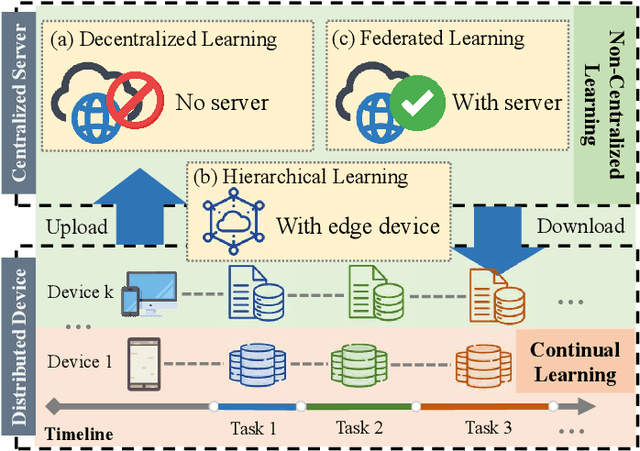
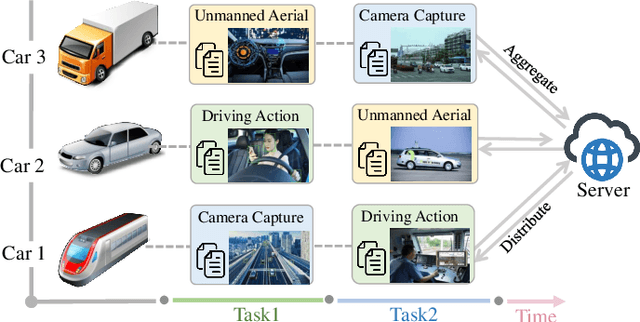
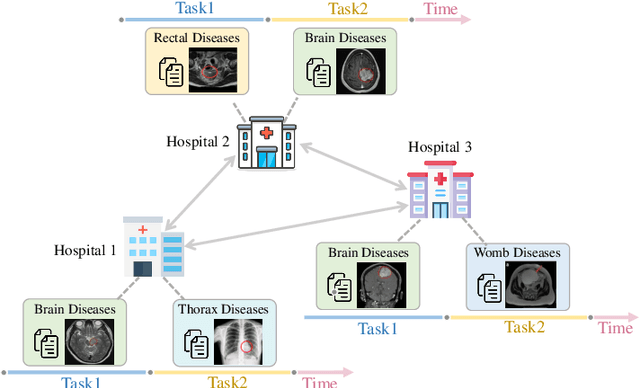
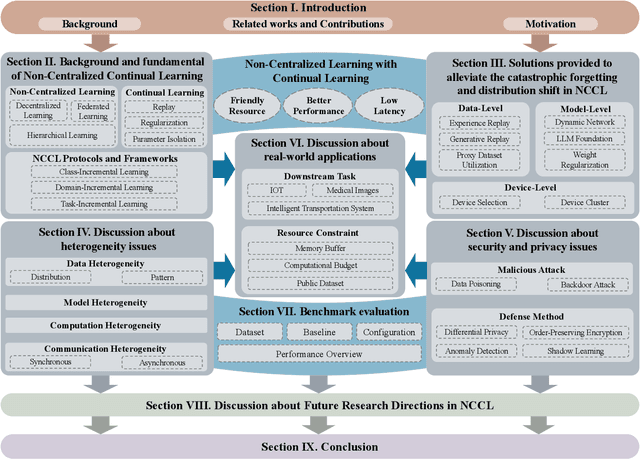
Abstract:Non-Centralized Continual Learning (NCCL) has become an emerging paradigm for enabling distributed devices such as vehicles and servers to handle streaming data from a joint non-stationary environment. To achieve high reliability and scalability in deploying this paradigm in distributed systems, it is essential to conquer challenges stemming from both spatial and temporal dimensions, manifesting as distribution shifts, catastrophic forgetting, heterogeneity, and privacy issues. This survey focuses on a comprehensive examination of the development of the non-centralized continual learning algorithms and the real-world deployment across distributed devices. We begin with an introduction to the background and fundamentals of non-centralized learning and continual learning. Then, we review existing solutions from three levels to represent how existing techniques alleviate the catastrophic forgetting and distribution shift. Additionally, we delve into the various types of heterogeneity issues, security, and privacy attributes, as well as real-world applications across three prevalent scenarios. Furthermore, we establish a large-scale benchmark to revisit this problem and analyze the performance of the state-of-the-art NCCL approaches. Finally, we discuss the important challenges and future research directions in NCCL.
New Emerged Security and Privacy of Pre-trained Model: a Survey and Outlook
Nov 12, 2024



Abstract:Thanks to the explosive growth of data and the development of computational resources, it is possible to build pre-trained models that can achieve outstanding performance on various tasks, such as neural language processing, computer vision, and more. Despite their powerful capabilities, pre-trained models have also sparked attention to the emerging security challenges associated with their real-world applications. Security and privacy issues, such as leaking privacy information and generating harmful responses, have seriously undermined users' confidence in these powerful models. Concerns are growing as model performance improves dramatically. Researchers are eager to explore the unique security and privacy issues that have emerged, their distinguishing factors, and how to defend against them. However, the current literature lacks a clear taxonomy of emerging attacks and defenses for pre-trained models, which hinders a high-level and comprehensive understanding of these questions. To fill the gap, we conduct a systematical survey on the security risks of pre-trained models, proposing a taxonomy of attack and defense methods based on the accessibility of pre-trained models' input and weights in various security test scenarios. This taxonomy categorizes attacks and defenses into No-Change, Input-Change, and Model-Change approaches. With the taxonomy analysis, we capture the unique security and privacy issues of pre-trained models, categorizing and summarizing existing security issues based on their characteristics. In addition, we offer a timely and comprehensive review of each category's strengths and limitations. Our survey concludes by highlighting potential new research opportunities in the security and privacy of pre-trained models.
Can Self Supervision Rejuvenate Similarity-Based Link Prediction?
Oct 24, 2024
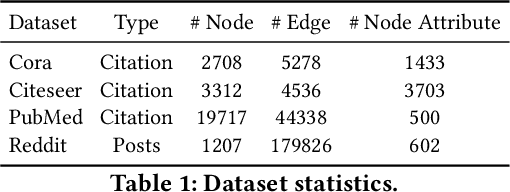
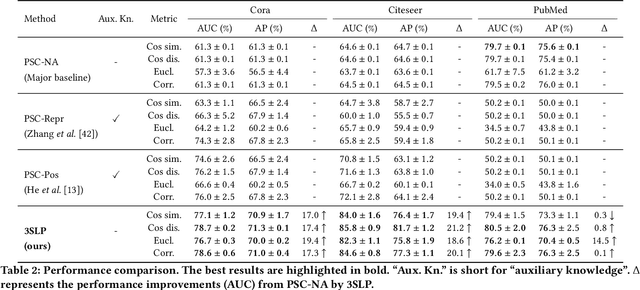
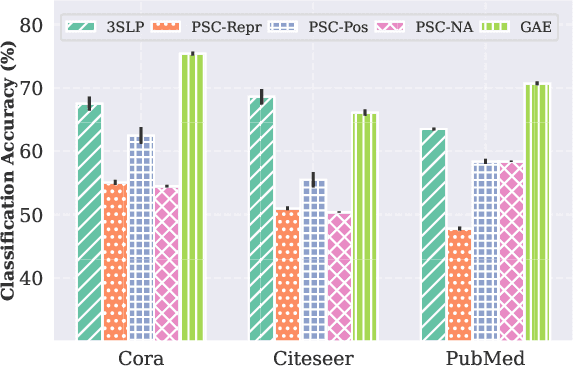
Abstract:Although recent advancements in end-to-end learning-based link prediction (LP) methods have shown remarkable capabilities, the significance of traditional similarity-based LP methods persists in unsupervised scenarios where there are no known link labels. However, the selection of node features for similarity computation in similarity-based LP can be challenging. Less informative node features can result in suboptimal LP performance. To address these challenges, we integrate self-supervised graph learning techniques into similarity-based LP and propose a novel method: Self-Supervised Similarity-based LP (3SLP). 3SLP is suitable for the unsupervised condition of similarity-based LP without the assistance of known link labels. Specifically, 3SLP introduces a dual-view contrastive node representation learning (DCNRL) with crafted data augmentation and node representation learning. DCNRL is dedicated to developing more informative node representations, replacing the node attributes as inputs in the similarity-based LP backbone. Extensive experiments over benchmark datasets demonstrate the salient improvement of 3SLP, outperforming the baseline of traditional similarity-based LP by up to 21.2% (AUC).
Joint Beamforming and Illumination Pattern Design for Beam-Hopping LEO Satellite Communications
Sep 16, 2024



Abstract:Since hybrid beamforming (HBF) can approach the performance of fully-digital beamforming (FDBF) with much lower hardware complexity, we investigate the HBF design for beam-hopping (BH) low earth orbit (LEO) satellite communications (SatComs). Aiming at maximizing the sum-rate of totally illuminated beam positions during the whole BH period, we consider joint beamforming and illumination pattern design subject to the HBF constraints and sum-rate requirements. To address the non-convexity of the HBF constraints, we temporarily replace the HBF constraints with the FDBF constraints. Then we propose an FDBF and illumination pattern random search (FDBF-IPRS) scheme to optimize illumination patterns and fully-digital beamformers using constrained random search and fractional programming methods. To further reduce the computational complexity, we propose an FDBF and illumination pattern alternating optimization (FDBF-IPAO) scheme, where we relax the integer illumination pattern to continuous variables and after finishing all the iterations we quantize the continuous variables into integer ones. Based on the fully-digital beamformers designed by the FDBF-IPRS or FDBF-IPAO scheme, we propose an HBF alternating minimization algorithm to design the hybrid beamformers. Simulation results show that the proposed schemes can achieve satisfactory sum-rate performance for BH LEO SatComs.
DDFAD: Dataset Distillation Framework for Audio Data
Jul 15, 2024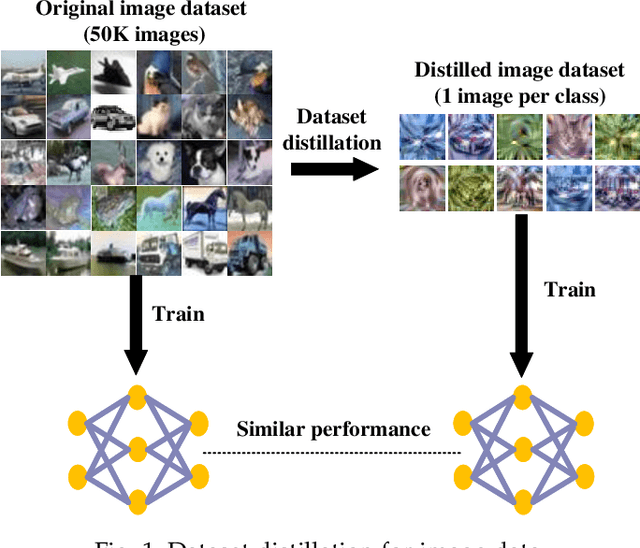
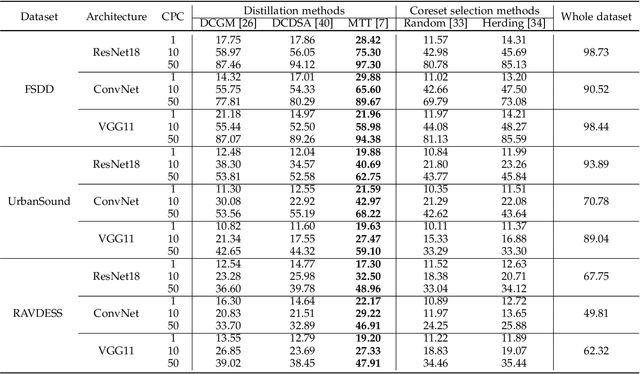
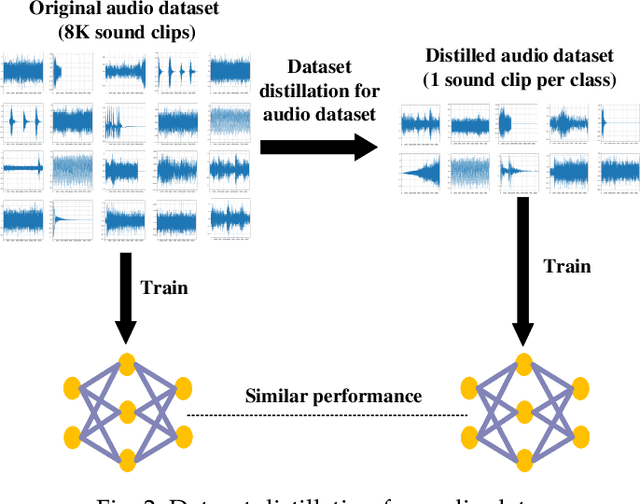
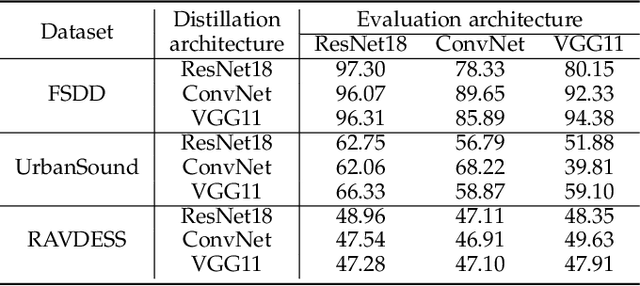
Abstract:Deep neural networks (DNNs) have achieved significant success in numerous applications. The remarkable performance of DNNs is largely attributed to the availability of massive, high-quality training datasets. However, processing such massive training data requires huge computational and storage resources. Dataset distillation is a promising solution to this problem, offering the capability to compress a large dataset into a smaller distilled dataset. The model trained on the distilled dataset can achieve comparable performance to the model trained on the whole dataset. While dataset distillation has been demonstrated in image data, none have explored dataset distillation for audio data. In this work, for the first time, we propose a Dataset Distillation Framework for Audio Data (DDFAD). Specifically, we first propose the Fused Differential MFCC (FD-MFCC) as extracted features for audio data. After that, the FD-MFCC is distilled through the matching training trajectory distillation method. Finally, we propose an audio signal reconstruction algorithm based on the Griffin-Lim Algorithm to reconstruct the audio signal from the distilled FD-MFCC. Extensive experiments demonstrate the effectiveness of DDFAD on various audio datasets. In addition, we show that DDFAD has promising application prospects in many applications, such as continual learning and neural architecture search.
Explainable AI Security: Exploring Robustness of Graph Neural Networks to Adversarial Attacks
Jun 20, 2024Abstract:Graph neural networks (GNNs) have achieved tremendous success, but recent studies have shown that GNNs are vulnerable to adversarial attacks, which significantly hinders their use in safety-critical scenarios. Therefore, the design of robust GNNs has attracted increasing attention. However, existing research has mainly been conducted via experimental trial and error, and thus far, there remains a lack of a comprehensive understanding of the vulnerability of GNNs. To address this limitation, we systematically investigate the adversarial robustness of GNNs by considering graph data patterns, model-specific factors, and the transferability of adversarial examples. Through extensive experiments, a set of principled guidelines is obtained for improving the adversarial robustness of GNNs, for example: (i) rather than highly regular graphs, the training graph data with diverse structural patterns is crucial for model robustness, which is consistent with the concept of adversarial training; (ii) the large model capacity of GNNs with sufficient training data has a positive effect on model robustness, and only a small percentage of neurons in GNNs are affected by adversarial attacks; (iii) adversarial transfer is not symmetric and the adversarial examples produced by the small-capacity model have stronger adversarial transferability. This work illuminates the vulnerabilities of GNNs and opens many promising avenues for designing robust GNNs.
 Add to Chrome
Add to Chrome Add to Firefox
Add to Firefox Add to Edge
Add to Edge